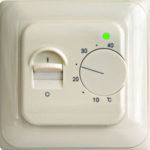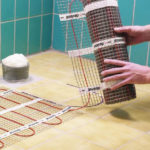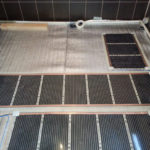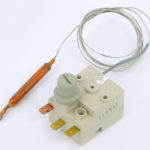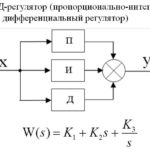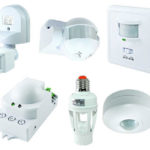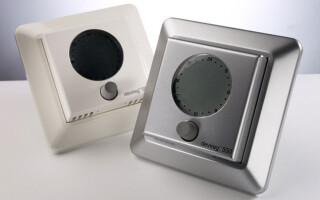Floor thermostat is used to properly manage the modern heating system, which should always maintain a comfortable temperature for your home. Operation is done using an element called a remote temperature sensor, which provides convenient control of floor and air space heating.
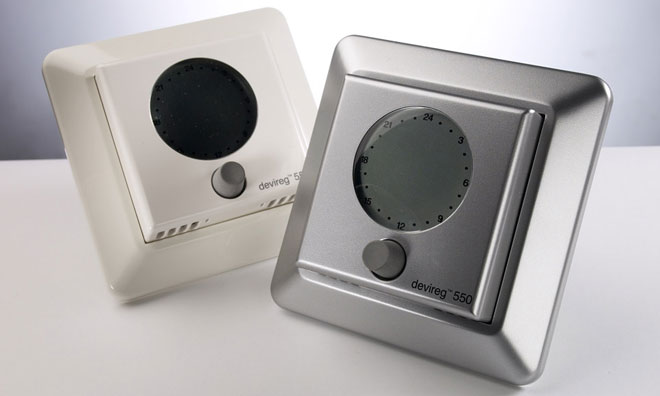
Installation of thermostats can be done in any room where there is a floor heating. With the help of these devices set the desired degree of heating. For some models, the possibility of touch control, equipping with additional temperature sensors is provided. They can be programmed for the desired temperature values at different times of the day, the same for days of the week.
Contents
Variety of thermostats for underfloor heating
Installing underfloor heating, the thermostat should be selected depending on the size of the heated area and the preferred power.
Mechanical thermostat
The easiest to control the device are thermostats of the mechanical type. They have a convenient control panel, which is often in the form of a rotary knob with a marked temperature scale.
Mechanical thermostats do not consume electricity to work, so their use seems more advantageous. Some devices have a timer, with which you can set the desired start time of heating.
The room temperature is determined by a built-in bimetallic temperature sensor. Its operation is based on the properties of gases or bimetallic elements: when the ambient temperature changes, they will change shape or volume. When the air temperature reaches the setpoint temperature, the circuit opens or closes. Such controllers have a hysteresis on the on-off switch, so that when the temperature setpoint is reached, the thermostat does not click back and forth.
Electronic thermostat
Electronic thermostat regulators without the possibility of programming are no less popular than mechanical regulators. Thanks to them it is possible to control the heat in the rooms with an accuracy of up to 0.5 ° C. Such a device is equipped with a handy display, which displays data on the floor temperature, both current and set.
If the system is on, it is indicated by a special sign that appears on the screen of the thermostat. Technical messages are also shown on the display, and symbols are displayed if there is a fault in the floor heating system. It is controlled by means of keys placed on the outside of the panel.
Heating elements are powered from the same source as mechanical thermostats. Using electronic devices, you can change the cycles of heating on and off, which saves resources and money to pay for them. The devices can run until the homeowners turn them off.
Programmable Thermostat
If the area that needs heating is large enough, the ability to save energy is important. This problem can easily be solved with a programmable thermostat, which is used both with film for film floor heating and with cable systems.
The principle of operation of the programmable-type thermostat is almost identical to the circuit used in simple devices. The main difference is the addition of the ability to adjust the operating modes by day. Intervals for temperature maintenance can be set for any day of the week. In this way, energy costs can be reduced by up to 70%.
For the operation of the device, the periods when it is necessary to maintain the heating at the maximum output or set the time for shutdowns. Processes are regulated automatically. You can make separate settings for weekdays and weekends. The set cycle will repeat until the owners change the settings.
Thermostat for electric floor heating
Thermostats are equipped with a convenient sensor that allows you to maintain the desired temperature by periodically turning the circuit on and off. The thermostat in the case of an increase in temperature triggers a relay. On a similar principle works thermostat for floors with infrared action, which is powered from the mains.
Most often, when assembling a heating system, a suitable thermostat is included. If your system is not equipped with one, you can purchase one. These units are available as standard units - they will fit most commercially available systems.
All thermostats are equipped with external and internal temperature sensors. The internal one is designed to measure the temperature of the floors, while the external one helps control the heating of the air in the room.
Temperature sensor is a conventional resistance thermometer. The principle of operation of such sensors is based on the dependence of the sensor resistance on the temperature of the ambient air in which it is located. For example, for a temperature sensor Pt100 type at 0 ° C, its resistance will be 100 ohms, similarly for a sensor 50M, only 50 ohms. As the temperature rises, the resistance will increase.
Then this measured resistance, the thermostat translates into degrees and based on the set point for regulation, performs the necessary actions, turns on or off the voltage to the floor heating.
Important: The type of temperature sensor must match the selected thermostat for the floor heating. Otherwise the resistance value of the sensor will not be correct and the regulation will not be correct.
When choosing a thermostat you have to take into account what the highest power value of the floor is. If this criterion is neglected, it will not be enough power, and the temperature will drop drastically. If necessary, the devices can be connected as a single network with a capacity greater than 3 kW. Installation is performed at different ends of the room separately.
How to choose a thermostat for underfloor heating
Without the right temperature regulator, full operation of the heating structure is not possible. With complete heating systems you can save both energy and money. The thermostat for underfloor heating performs simple tasks - it switches the heating on or off at a pre-selected time. The function can also be carried out according to the readings of the device.
When choosing a regulating device to be built into the heating system, it is necessary to consider the power - it must correspond to the same indicator in the heating structure. On what kind of thermostat is installed and how it works, depends not only on comfort in the room, but also the safety of coverage on the floor.
Among the models of thermoregulators the following groups are distinguished:
- Devices, thanks to which it is possible to provide savings in operation - they help to reduce energy consumption if the owners of the house will be away for some time. During this period, the heating power is slightly reduced.
- Devices with the possibility of programming the floor heating temperature sensor. Using this function allows you to set the period when the room will be heated with the required intensity. The command given by the timer is transmitted to the regulating device, after which it will maintain the set temperature at the desired level.
- Intelligent, capable of programming the operating modes, where the economy and heating modes are alternately applied. When using such a device, the command from it at the right time goes directly to the heating element. The time is determined depending on the pre-set by the user or on the changes in the atmosphere outside.
- Devices that include a built-in limiter sensor. It helps to protect both the floor covering and the heating element from overheating. The use of such a device is particularly useful if the floor is laminate, which cannot tolerate large temperature differences.
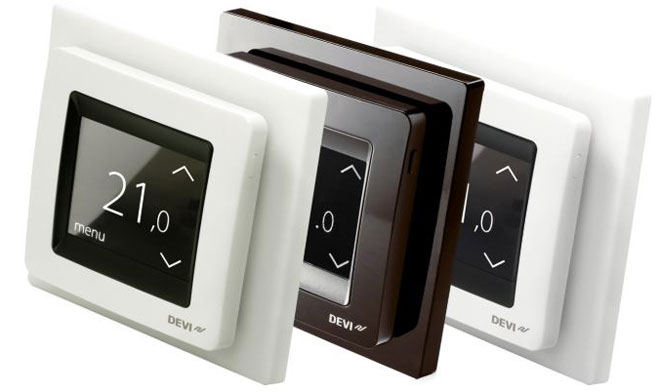
The device for temperature control is chosen on the basis of the area of the room. So, for a small room, a simple device, the work of which does not provide the possibility of programming, is enough. For large areas, it is necessary to look for devices more complicated, providing the possibility of programming. For such purposes, thermostats with special sensors that are installed inside the floor can be used.
Devices for regulation can be overhead or recessed - information about this is contained in the instructions attached to the product. When choosing, you should consider the type of control, assess the ease of installation, adjustment and use for existing conditions.
Installation of a floor heating controller
When opening the front panel of the thermostat, follow the procedure specified in the manual. It should also include a wiring diagram for the thermostat. To install the device of built-in type, you must first prepare a special recess for it. Location of the thermostat is chosen at a height of about 1 m from the floor. Household power supply should be de-energized beforehand.
Start the installation of the thermostat by connecting the power supply to the mounting box. Between the thermostat and the heating elements is placed the connected temperature sensor, which is inserted into the corrugated pipe.
For correct connection of the wires to the thermostat, use the diagram provided by the manufacturer. Special terminals are provided for connecting the wires. The ones that supply power to the sensor are connected to the sockets that have special markings. The device is placed in the mounting box, the thermostat is aligned. If necessary, install RCD, grounding wire. Then put the control panel in place and fix it with fasteners.
Setting the Thermostats
Different models of thermostats are capable of working in automatic or manual mode. Programmable electronic devices allow you to arrange the mode for the days of the week or time of day that users want. When the thermostats are installed, an in-depth type setting or calibration can be performed. One of the temperature sensors can be disabled if needed.
The manufacturer specifies the steps to be taken when adjusting, as well as the location of the sensors, in the operating instructions. You can lock the device so that someone (e.g., children) can not inadvertently disable the settings.
Related articles:
